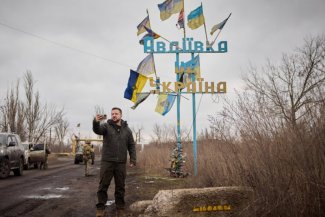The fight for Avdiivka intensifies. Day 712 of the war

![]()
At the beginning of February, Russian troops broke through the Ukrainian defences north-east of Avdiivka and entered the town from the north. The Ukrainian forces which had previously been holding back the Russian advance in the area risked having their supply lines cut off and retreated to Avdiivka. The invaders continued their advance towards the O0542 road, which runs along the town’s western border and represents its defenders’ main logistical line. According to some sources, on 6 February the Russians crossed the railway line between the built-up area and the coke plant located in the north-western part of Avdiivka, with less than a kilometre to reach this road. The invaders’ subunits also made further advances south of the town and its south-western outskirts, repelling Ukrainian counter-attacks. The defenders will have to direct additional forces there in order to halt the Russians’ further advances and prevent Avdiivka’s loss, something which Ukrainian commentators believe is not guaranteed. The command, headed by General Valerii Zaluzhnyi, has for some time been considering surrendering the town, which is becoming increasingly difficult to defend. The pressure to hold it – as was the case with Bakhmut – is coming from the government and President Zelensky.
Ukrainian forces have halted the Russian advance south-east of Kupyansk, and the intensity of Russian attacks in this direction has decreased (a new front line has been formed west of Tabaivka and Krokhmalne). However, the invaders have made further advances west of Kreminna and Bakhmut, and west and south of Marinka. The situation in the other directions has not significantly changed. According to the Ukrainian General Staff, on 5 February the intensity of enemy attacks in most directions rapidly increased, reaching a record 126 in the day. In the period from 31 January to 4 February, the frequency of enemy assaults fluctuated at around 70 per day.
On 3 February, soldiers of the territorial defence forces in the Glukhov area of Sumy oblast detected a Russian sabotage and reconnaissance group (SRG). After the Ukrainian forces called for reinforcements and opened mortar fire, the enemy split into two groups and withdrew under cover of their own artillery. On 5 February, Ukrainian forces indicated that the enemy SRG was made up of 10 to 12 well-trained military intelligence and spetsnaz officers. In addition to reconnaissance, their task is to harass soldiers and civilians in the border areas.
The Metinvest conglomerate, which is owned by the oligarch Rinat Akhmetov, is busy erecting fortifications as part of its Steel Front programme. On 31 January it was announced that more than 330 fortified resistance positions had been handed over to the army. The command posts, each consisting of six shelters, will be constructed after contracts were signed with the army. Around 500 of the corporation’s employees have been assigned to the work.
On 31 January 207 Ukrainian soldiers and civilians returned from captivity. The alleged deaths of 65 prisoners of war following the crash of a Russian Il-76 transport plane near Belgorod have still not been confirmed; the Russians have still not provided evidence of their deaths.
![]()
The invaders have reduced their use of missiles and kamikaze drones, focusing on the frontline areas. On 2 and 3 February, power and heating infrastructure in and around Kryvyi Rih was attacked. 40,000 subscribers, including local industries, were cut off from energy supplies. Kryvyi Rih was also attacked on 31 January. In addition, Russian drones and missiles struck Kharkiv (30 and 31 January) and Kharkiv oblast; Kropyvnytskyi (2 February) and Kirovohrad oblast; and the Mykolaiv and Poltava oblasts. From the evening of 30 January to the morning of 6 February, the invaders used 28 missiles (including Iskander ballistic missiles); according to the defenders’ statements, three of these were shot down. Up to and including 3 February, the invaders also used 73 Shahed-136/131 drones (39 of which were reported downed). From 4 February until the morning of 6 February, no use of Shaheds was reported; the Ukrainian side explains this in terms of the enemy’s search for new attack paths. Breaks of two to three days in kamikaze drone attacks have also occurred in previous months. The situation is different in the case of missiles, which the Russians are using daily (in smaller numbers; 11 January was the only day since the beginning of the year on which no Russian missile fell on Ukraine). Local Ukrainian sources, on the other hand, report that the enemy’s use of guided aerial bombs, whose targets included Kherson city, has increased significantly in recent days.
![]()
In late January and early February, Ukrainian forces carried out further attacks in occupied Crimea. According to the Strategic Communications Board of the Ukrainian Armed Forces, on 30 January a radar station of the air defence system near Rozdolne in the north of the peninsula was hit. The following day, Ukrainian missiles (most likely Storm Shadow/SCALP cruise missiles) hit the Belbek airfield north of Sevastopol. Some sources reported that a command post was hit, killing retired General Aleksandr Tatarenko (he was listed as a squadron commander; it cannot be ruled out that he had returned to duty due to the ongoing expansion of Russian military aviation) as well as 10 other servicemen, together with a communications post. On 2 February, Ukrainian Air Force spokesman Colonel Yuri Ihnat announced that at least three aircraft were hit in the 31 January attack and “some personnel were destroyed”, which has apparently been confirmed by satellite images and obituaries in the Russian media.
On 1 February Ukrainian surface drones sank the Ivanovets, a small missile corvette (a missile cutter in Russian nomenclature) off the roadstead of Lake Donuzlav in Crimea. According to a report from Ukrainian military intelligence (HUR), the ship was hit by six MAGURA V5 UAVs. This would imply that the crew of the Ivanovets completely disregarded the threat; they were most likely hoping that their vessel, which was of an older type and was not participating in the operations against Ukraine, would not be targeted. With regard to newer vessels, especially the Kalibr cruise missile carriers, the invaders developed procedures for their defence back in 2022; these allow them the vessels to be protected relatively effectively against the enemy’s surface drone attacks, which take place several times a month. The Ivanovets is the first Russian ship sunk in this manner. In August 2023, Ukrainian drones severely damaged the landing ship Olenegorsky Gornyak in Novorossiysk, and have caused light damage to other vessels on several occasions.
The Ukrainians are continuing their attacks on the Russian oil industry. On 31 January the wreckage of a kamikaze drone was said to have fallen on the premises of the Nevsky Mazut enterprise near St Petersburg, causing a fire there. An attack on a refinery in Volgograd on 3 February had a similar result.
On 30 January, HUR reported on a hacking attack in which the Russian defence ministry’s server was damaged. This disrupted communications between the ministry’s organisational cells.
![]()
Ukraine needs 200,000 155-mm artillery shells per month. On 31 January, the Bloomberg news agency reported that Ukraine’s defence minister Rustem Umierov had approached his EU counterparts about the issue. Current consumption averages 60,000 shells per month. On the same day, the EU High Representative for foreign affairs and security policy Josep Borrell stated that as of March 2023, Kyiv had received 330,000 artillery shells from the member states’ reserves. By the end of March this year, this figure is expected to rise to 524,000, or 52% of the promised 1 million munitions; these are to come from stocks and individual and joint purchases by EU countries. By the end of 2024, the EU is to supply Ukraine with 630,000 more rounds. If these promises are kept, Kyiv will have received an average of 75,000 shells per month from the EU by the end of this year. In order to reach the average level of artillery shell consumption of the first several months of the war (5000 per day), the army would have to receive a similar number from the United States. Meeting the needs stated by Minister Umierov would require the US to supply 125,000 per month (it seems unlikely that any new countries will join in the process of supplying ammunition to Ukraine). On 6 February, the US Army’s procurement officer outlined plans to increase the production of artillery shells from the current level of 28,000 per month to 37,000 in April and 60,000 in October this year, followed by 75,000 in April and 100,000 in October 2025.
![]()
On 1 February, General Zaluzhnyi stated in an article on CNN that the use of unmanned systems, along with other types of advanced weaponry, is the best way for Ukraine to avoid positional warfare, in which its army would not have the advantage. He acknowledged that the state’s institutions cannot improve the manning of the armed forces without resorting to unpopular measures. According to Zaluzhnyi, in 2024 the government should focus on three areas concerning the continued prosecution of the war: creating a system to ensure the army is supplied with state-of-the-art resources; introducing a new philosophy of training and warfare that takes resource constraints and methods of use into account; and mastering new combat capabilities as soon as possible. He added that the Armed Forces face the challenge of creating a new state system for retrofitting technology. He also drew attention to the partial monopolisation of the defence industry and the imperfect parliamentary legislation, which has caused problems in arms production.
On 5 February, in an interview with the Italian TV station RAI 1, President Zelensky stated that the situation at the front was stagnating due to delays in the delivery of military equipment and ammunition. He admitted that he is inclined towards dismissing General Zaluzhnyi, but in doing so he intends to carry out a wide-ranging personnel reshuffle, not just within the army, but also in the state administration as a whole. This personnel reset is to be used to bring in people who are well motivated and not subject to ‘despair’. On 5 February, the minister for veterans’ affairs Yuliya Laputina resigned from her post. Commenting on her resignation Zelensky stated that following a discussion with Prime Minister Denys Shmyhal, he considered it necessary to change the way in the ministry is managed and to regain the trust of veterans.
On 6 February the Security Service of Ukraine (SSU) announced the detention of five people working for the Russian FSB in various regions of the country. They include former employees of the HUR and the Foreign Intelligence Service, and an officer from one of the SSU’s regional boards. The intelligence network was tasked with providing information on the armed forces, supplies of Western armaments, and energy infrastructure facilities, including the security system of the Rivne Nuclear Power Plant and the Khmelnytskyi Nuclear Power Plant.
![]()
On 4 February, the Ukrainian government reported that Russian prisoners recruited for military service were being incorporated into an assault battalion called ‘Storm Gladiator’ which is in the process of being formed. The unit is commanded by a former police officer who was convicted of a brutal murder.
![]()
The Russians are planning to resettle citizens of the Russian Federation, Belarus and Kazakhstan in the occupied part of Zaporizhzhia oblast as part of the ‘Virgin Lands of Zaporizhzhia’ programme. According to the Ukrainian government, this is intended to facilitate the suppression of resistance by the local population and to make up for shortages of staff in local enterprises, especially construction.
On 5 February, the ‘minister for emergency situations’ of the so-called Luhansk People’s Republic, Aleksei Poteleshchenko, was killed during the Ukrainian artillery shelling of Lysychansk in Luhansk oblast.






